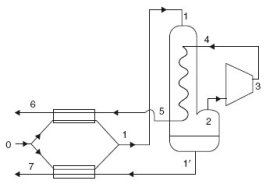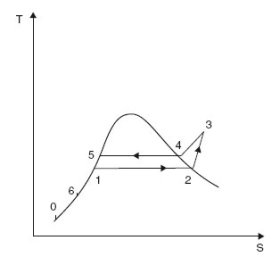Mechanical vapor compression (VC)
MECHANICAL VAPOR COMPRESSION
In most situations that would be suitable for the use of a heat pump (small temperature difference between a "free" cold source and heat needs), mechanical vapor compression is presented as an efficient alternative if the cold source is a gas or vapor. It is then possible to avoid the evaporator, possibly the condenser, and thus achieve high performance.
Indeed, compression of a vapor (steam or gas in a process) allows its pressure and temperature to be raised, and thus its enthalpy. If the compressed vapor can be recovered either in a process, or in terms of energy, the compression operation can be very attractive economically.
The two most conventional mechanical vapor compression (VC) applications are distillation and concentration by evaporation. It can also be used for recovery of waste heat.
EVAPORATIVE MECHANICAL VAPOR COMPRESSION CYCLE

In an evaporative mechanical vapor compression cycle (Figure above), the idea is to raise the solvent vapor enthalpy level so that it can be directly used to provide heat to the evaporator.
The basic scheme is as in Figure above and its cycle is plotted on the entropy diagram of Figure below: in 0, the product to be concentrated is brought in two heat recovery exchangers where it is preheated (0-1) by cooling the concentrated product ((1'-7)) and condensate ((5-6)).

In the evaporator, the product to be concentrated is partially evaporated (1-2) by exchange with its own vapor, which condenses (4-5).
At the bottom of the evaporator, the concentrate is extracted in 1', while the solvent vapor exits in 2 to be recompressed in 3, and gain enough enthalpy to be able to serve as cycle hot source. To ensure large heat exchange coefficients (two-phase) in the evaporator, steam is frequently desuperheated from 3 to 4 via a separate heat exchanger, cooled by desuperheating water, even if that requires a steam addition in 4.
The energy interest of the operation is that by providing little additional enthalpy h23 (but a mechanical one), it is possible to recover the solvent vapor condensation enthalpy h45. As an indication, if the solvent is water, which has a very high heat of vaporization (almost 10 times that of oil), h23 is in practice between 3 and 9% of h45.

The figure above presents a modification of the single-effect evaporator presented in the thematic page on evaporation , at which was added a steam mechanical compression for much of the heat supply. The input steam flow is divided by a factor greater than 3, while the compressor power is only 200 kW. Ratio (steam evaporated) / (heating steam) is 2.2.
DESIGN PARAMETERS OF A VC
To design and size a VC installation, one must know precise characteristics of the fluid being treated, and in particular, in addition to general thermodynamic data:
concentrations Ci and Co at the evaporator inlet and outlet. If the fluid flow at the entrance is mfi, the flow of solvent to evaporate is: ms = mfi (1 - Ci/Co);
the boiling point elevation (see thematic page on evaporation ): depending on the nature of the solute and its final concentration, boiling occurs at a temperature different from that corresponding to the solvent saturation pressure, the gap being up to several tens of degrees Celsius. This elevation depends on the solutions considered. In the case of water, it can lead to increase the compression ratio, and therefore costs;
thermosensitivity: some products do not stand being processed at too high a temperature or for too long periods of time. This results in specific constraints for processing devices, which it is preferable to take into account in the design phase;
viscosity can vary significantly from one product to another. It increases with the concentration and decreases with temperature. Its value determines the capacity of circulating pumps;
non-condensable gases drawn or dissolved in the fluid to concentrate reduce heat exchange coefficients. Their extraction can require vacuum pumps, of sometimes important capacity. Careful maintenance of these facilities is crucial for the proper functioning of the whole;
corrosion: the choice of materials to select, and therefore the cost of various organs is determined by how aggressive are fluids that run through the installation, whether the fluid to treat or cleaning products.
